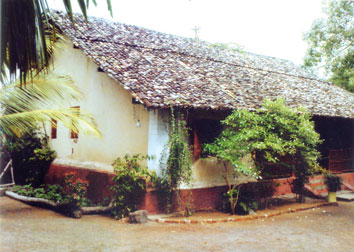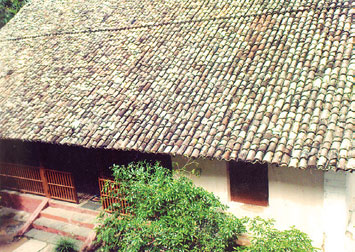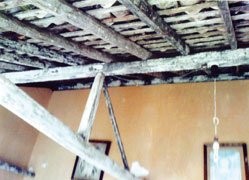|
The biggest pirivena of the Kotte period:
Buried in the sands of time
by Padma EDIRISINGHE
 Tucked away a short distance from the Southern coastal road between
Hikkaduwa and Ambalangoda, there looms the Thotagamu Rajamaha Vihara.
Even the name board on the highway indicates only this status. But only
the literati of Lanka know that here flourished the most famous of the
many Pirivenas that made the Kotte period one of the most academically
equipped periods of Lankan history. A tragic observation that the writer
made on a recent visit to this Vihara is that visual evidence of this is
limited to a few ruined buildings that dot a most picturesque landscape
almost within sight of the Indian ocean which however led to a grisly
devastation and depopulation of the area by the 2004 tsunami. What
different destinies landscapes cum buildings become heir to, in the long
trek of history! Tucked away a short distance from the Southern coastal road between
Hikkaduwa and Ambalangoda, there looms the Thotagamu Rajamaha Vihara.
Even the name board on the highway indicates only this status. But only
the literati of Lanka know that here flourished the most famous of the
many Pirivenas that made the Kotte period one of the most academically
equipped periods of Lankan history. A tragic observation that the writer
made on a recent visit to this Vihara is that visual evidence of this is
limited to a few ruined buildings that dot a most picturesque landscape
almost within sight of the Indian ocean which however led to a grisly
devastation and depopulation of the area by the 2004 tsunami. What
different destinies landscapes cum buildings become heir to, in the long
trek of history!
The booklet on the temple informs that Mahavamsa attributes the name
Thiththagaama to Thotagamuwa or the village of the Ford Theertha gama.
It was where Molapu Oya met the Indian ocean. MV further informs that
Vijayabahu the Great (Polonnaruwa period) was responsible for the
grandiose monastic building of this Rajamaha Vihara who also had gone on
to house the Pirivena. For its later additions Parakramabahu 1V is given
credit. So though the connection of the 2nd capital is evident, certain
architectural evidence is cited copiously to ascribe some structures to
the Anuradhapura period taking the roots of the famous site to a time
epoch further back. Yuvaraj Mahanaga sent by king Devanampiyatissa (3rd
C BC) to colonise the South is said to be responsible for the initial
beginnings.
Whatever the beginnings were it was these Pirivenas that kept the
torch of learning burning during the ancient and medieval periods of the
island but then came troubled times and dwindling of royal support that
they gradually faded into oblivion so much so that Colebrooke who came
to Lanka in 1833 during the British period heading a premier education
Commission states that as seats of learning the Pirivenas are hardly
worthy mentioning! But this narrative is not about all these Pirivenas
born out of Buddhist Hela culture but about a single one. It had its
vicissitudes peaks and falls.
 The “Peakest” period was when it was headed by the most erudite
scholar and brilliant poet of the time, Sri Rahula Thera. That was the
15th Century, a period dominated by the Chakravarthi rule of
Parakramabahu V1 when literary efflorescence slowly grew into a
crescendo. Sri Rahula was the brightest star. His relationship with the
Chakravathi king is not much clear. The “Peakest” period was when it was headed by the most erudite
scholar and brilliant poet of the time, Sri Rahula Thera. That was the
15th Century, a period dominated by the Chakravarthi rule of
Parakramabahu V1 when literary efflorescence slowly grew into a
crescendo. Sri Rahula was the brightest star. His relationship with the
Chakravathi king is not much clear.
He is known to have been nurtured in the Palatial Complex, probably
singled out due to his genius but his later connection with the Kotte
kings seems to have been soured. He lived long enough to develop an
issue with Bhuvanekabahu V1 alias Sapumal Bandara, conqueror of Jaffna.
In the whirl of confusing facts presented in that booklet we see the
monk now in an elderly stage of life fleeing to Thotagamuwa area in the
South (The larger area is now known as Telwatte). That could be his
native area for Vidagama thera had addressed him as Thotagamuwe Rahula
in his Samanera days. It can be surmised however that as a lad the
famous prelate had haunted the Vidagama area probably staying with
relatives for the equally famous Vidagama thera seems according to
legend, to accost him in typical adolescent activities as fishing and
even along village bypaths trod by Vidagama paying compliments to pretty
women via verse forgetting all about Samsaric tentacles.
Any advice the prelate gave the lad on these occasions the latter had
responded with pithy and humorous verse. Vidagama thera impressed had
introduced him to the Kotte royal court of Parakramabahu V1 where he
became a top favourite and gained fame as a promising scholar and
budding poet. Having settled later at Thotagamuwa he indulged in many a
literary work.
Thus it can be safely surmised that the Thotagamuwa Vihara mastered
by him as head of the Vihara zoomed to be the spawning ground of the
most magnificent works in the arena of Sinhala literature produced
during this period.
 These include Kavyasekhera, Parevi Sandesha and Selalihini Sandesha
all extremely mellifluous poetic works plus very significant academic
works such asPanchika Pradeepa, Buddha Gadhya and Buddhippasadani. These include Kavyasekhera, Parevi Sandesha and Selalihini Sandesha
all extremely mellifluous poetic works plus very significant academic
works such asPanchika Pradeepa, Buddha Gadhya and Buddhippasadani.
The Vijayaba Pirivena he headed shed its intellectual lustre even in
Asian countries owning a very wide curriculum spanning diverse subjects
as the Buddhist doctrine, Grammar, the languages of Sanskrit, Magadha,
Elu and Tamil and areas of higher study as the Vedas, Arthasasthra
(Economics), astrology and medicine. One can visualise a vast complex
brimming with academic activity.
That was the 15th century and inevitably followed the 16th century
marked by the European voyages of discovery subsequent to the
Renaissance and the Industrial Revolution.
Arrived the Portuguese influenced by the Papal orders that all
institutes that promoted non Christian values have to be wiped off the
face of the earth. So in 1580 Thome de Souza directed his onslaught on
the great pirivena decimating it to four granite columns. Asking for a
resurrection of Thotagamuwa Vijayaba Pirivena is just asking too much.
But its present neglect after such a long passage of time is almost
unforgivable. The pictures articulate the sorry plight of this
institution that attracted hundreds of overseas students. It is time to
wade into action at least in memory of one of the greatest scholars and
poets the country produced.
|

